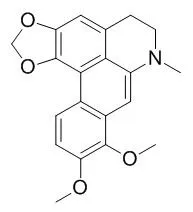| In vitro: |
| Planta Med. 2011 Sep;77(13):1519-24. | | Cytotoxic and antimicrobial activities of aporphine alkaloids isolated from Stephania venosa (Blume) Spreng.[Pubmed: 21305448] |
METHODS AND RESULTS:
The cytotoxic activity of five alkaloids, namely 4,5-dioxo-Dehydrocrebanine (1), Dehydrocrebanine (2), crebanine (3), oxostephanine (4), and thailandine (5) isolated from the tuber and leaves of Stephania venosa (Blume) Spreng was investigated.
CONCLUSIONS:
Thailandine showed the strongest activity against lung carcinoma cells (A549) (IC50 of 0.30 µg/mL) with very low cytotoxicity against normal embryonic lung cells (MRC-5). Thailandine also demonstrated strong activity against Plasmodium falciparum, K1 strain (IC50 of 20 ng/mL), and Mycobacterium tuberculosis H(37)Ra (MIC of 6.25 µg/mL) as well as gram-positive bacteria such as Streptococcus pneumoniae and Staphylococcus aureus. Oxostephanine exhibited strong activity against breast cancer (BC) and acute lymphoblastic leukemia cells (MOLT-3) with an IC50 of 0.24 and 0.71 µg/mL, respectively, and exhibited very low cytotoxicity against MRC-5 cells. Dehydrocrebanine demonstrated strong activity against promyelocytic leukemia cells (HL-60) with an IC50 of 2.14 µg/mL whereas crebanine showed weak activity against cancer cell lines. However, both of them showed cytotoxicity against MRC-5 cells. | | Planta Med. 1999 Dec;65(8):754-6. | | Antimalarials from Stephania venosa, Prismatomeris sessiliflora, Diospyros montana and Murraya siamensis.[Pubmed: 10630122 ] |
METHODS AND RESULTS:
Fourteen compounds isolated from Stephania venosa, Prismatomeris sessiliflora, Diospyros montana and Murraya siamensis were tested for their antimalarial potential.
CONCLUSIONS:
The 6a,7-dehydroaporphine alkaloids dehydrostephanine and Dehydrocrebanine showed potent activity with IC50 values of 40 and 70 ng/ml, respectively. The 13C-NMR data of rubiadin, rubiadin-1-methyl ether, diospyrin and 5-hydroxy-4-methoxy-2-naphthal-dehyde were extensively studied. |
|






 Cell. 2018 Jan 11;172(1-2):249-261.e12. doi: 10.1016/j.cell.2017.12.019.IF=36.216(2019)
Cell. 2018 Jan 11;172(1-2):249-261.e12. doi: 10.1016/j.cell.2017.12.019.IF=36.216(2019) Cell Metab. 2020 Mar 3;31(3):534-548.e5. doi: 10.1016/j.cmet.2020.01.002.IF=22.415(2019)
Cell Metab. 2020 Mar 3;31(3):534-548.e5. doi: 10.1016/j.cmet.2020.01.002.IF=22.415(2019) Mol Cell. 2017 Nov 16;68(4):673-685.e6. doi: 10.1016/j.molcel.2017.10.022.IF=14.548(2019)
Mol Cell. 2017 Nov 16;68(4):673-685.e6. doi: 10.1016/j.molcel.2017.10.022.IF=14.548(2019)